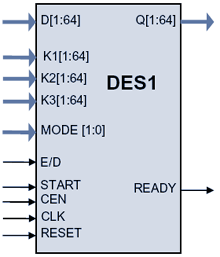|
|
 |
|
|
DES1
Ultra-Compact Data Encryption Standard (DES/3DES) Core
|
|
General Description
The DES1 ASIC/FPGA core is an implementation of the DES and triple DES
encryption and decryption in compliance with the
NIST Data Encryption Standard. It processes 64-bit blocks, with one, two, or three 56-bit keys.
Basic core is very small (3,000 ASIC gates).
Enhanced versions are available that support
various cipher modes (ECB, CBC, OFB, CFB,
CTR).
The design is fully synchronous and available in
both source and netlist form. Test bench
includes the NIST DES test vectors.
DES Core is supplied as portable Verilog (VHDL
version available) thus allowing customers to
carry out an internal code review to ensure its
security.
Symbol
 |
Base Core Features
Encrypts and decrypts using the DES / TDEA / Triple DES / 3DES Block
Cipher Algorithm
High throughput: up to 3 Gbps at 750 MHz in
90 nm LV technology
Small size: from 3K ASIC gates for a triple
DES core
Satisfies FIPS 46-3 from the US National
Institute of Standards and Technology (NIST)
Processes 64-bit data blocks
Employs one to three keys of 56 bits each
Completely self-contained: does not require
external memory
Available as fully functional and synthesizable
Verilog, or as a netlist for popular
programmable devices and ASIC libraries
Deliverables include test benches
Applications
- Secure mobile phone communications
- Secure RFID
- Secure Smart Cards
- Secure financial transactions
- SCTE 52
|
|
| |
Pin Description
| Name |
Type |
Description |
| CLK |
Input |
Core clock signal |
| RESET |
Input |
Core reset signal |
| CEN |
Input |
Synchronous enable signal. When LOW the core ignores all its inputs and all its
outputs must be ignored. |
| START |
Input |
When goes HIGH, a cryptographic operation is started |
| E/D |
Input |
Encrypt (1) / Decrypt (0) |
| MODE[1:0] |
Input |
DES mode
- 0 – Single DES
- 1 – Double DES
- 2 – Triple DES (3DES, TDEA)
|
| READY |
Output |
Output data ready and valid |
| K1[1:64] |
Input |
First Encryption Key |
| K2[1:64] |
Input |
Second Encryption Key (used only in Double or Triple mode) |
| K3[1:64] |
Input |
Third Encryption Key (used only in Triple mode) |
| D[1:64] |
Input |
Input Plain or Cipher Text Data |
| Q[1:64] |
Output |
Output Cipher or Plain Text Data |
|
|
| |
Function Description
A DES encryption operation transforms a 64-bit block into a block of the same size. The encryption key size is 56
bits, with one to three keys used. The block performs DES and Triple
DES (TDEA) encryption as defined by NIST in FIPS publication 46-3. |
|
| |
Operation
A rising input on the START port triggers the beginning of a cryptographic operation on the data D, using the
KEY as key. The core then starts to process the state according to the DES algorithm.
When all the rounds are completed, the READY signal is raised and the encrypted data is available on the
output.
It is possible to start a new cryptographic operation as soon as the data from the previous one is output. A
cryptographic operation can be aborted at any time by lowering the START signal for at least one clock cycle.
The core is fully pipelined. Loading of the new plain/cipher text data and key can be combined with outputting
cipher/plain text data from the previous operation.
New key can be used for each cryptographic operation. The absence of gaps allows sustaining the throughput
of 4/2/1.33 bits per clock for DES / 2DES / 3DES correspondingly. |
|
| |
Implementation Results
Representative area/resources figures
are shown below.
| Technology |
Max Frequency |
Area |
DES Throughput |
3DES Throughput |
| TSMC 130 nm |
234 MHz |
3,117 gates |
936 Mbit/s |
312 Mbit/s |
| TSMC 130 nm |
512 MHz |
4,482 gates |
2,048 Mbit/s |
684 Mbit/s |
| TSMC 90 nm |
358 MHz |
3,192 gates |
1.4 Gbit/s |
477 Mbit/s |
| TSMC 90 nm |
789 MHz |
5,090 gates |
3.15 Gbit/s |
1 Gbit/s |
| Altera Stratix II |
133 MHz |
466 ALUT |
1.06 Gbit/s |
335 Mbit/s |
| Altera Stratix II |
180 MHz |
362 ALUT |
720 Mbit/s |
240 Mbit/s |
|
|
|
| |
|
| |
Deliverables
|
HDL Source Licenses
- Synthesizable Verilog RTL source code
- Testbench (self-checking)
- Test vectors
- Expected results
- User Documentation
|
|
|
Netlist Licenses
- Post-synthesis EDIF
- Testbench (self-checking)
- Test vectors
- Expected results
|
|
|
| |
|
|
|

